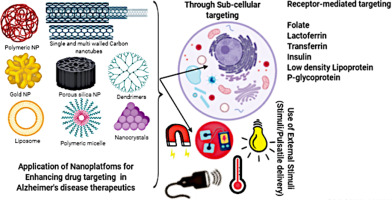当前位置:
X-MOL 学术
›
J. Control. Release
›
论文详情
Our official English website, www.x-mol.net, welcomes your feedback! (Note: you will need to create a separate account there.)
Receptor specific, stimuli responsive and subcellular targeted approaches for effective therapy of Alzheimer: Role of surface engineered nanocarriers.
Journal of Controlled Release ( IF 10.8 ) Pub Date : 2019-12-19 , DOI: 10.1016/j.jconrel.2019.12.034 Divya Gopalan 1 , Abhijeet Pandey 1 , Nayanabhirama Udupa 1 , Srinivas Mutalik 1
Journal of Controlled Release ( IF 10.8 ) Pub Date : 2019-12-19 , DOI: 10.1016/j.jconrel.2019.12.034 Divya Gopalan 1 , Abhijeet Pandey 1 , Nayanabhirama Udupa 1 , Srinivas Mutalik 1
Affiliation

|
The present review deals in-depth with the current application of nanotechnology in targeting the major pathological hallmarks of Alzheimer's disease. This review further focuses on the surface modification of the nanocarriers using antibody, aptamers, proteins and peptides for specific targeting in the brain by overcoming the biological barriers such as blood brain barrier. The stimuli responsive/pulsatile drug delivery nanoplatforms using stimuli such as pH, temperature, photo-thermal, reactive oxygen species, ultrasonic stimulation and electrical stimulation, which help to create a micro-environment to either trigger the site-specific drug release from the nanoplatform or to reduce the disease burden in the brain, have been discussed. The targeting of nanoplatforms to sub-cellular compartments such as mitochondria, nuclei, endoplasmic reticulum, golgi apparatus and lysosomes along with receptor specific interactions such as such folate, lactoferrin, transferrin, insulin and low-density lipoprotein (LDL) receptors has been included to give reader an idea about strategies to enhance cellular co-localization and receptor based targeting of nanoparticles to enhance efficacy of delivery platform. This article describes the various type of nanoplatforms which include lipidic nanoplatforms, polymeric nanoplatforms, inorganic nanoplatforms (metallic nanocarriers, quantum dots, ceramic based nanocarriers), carbon based nanocarriers and cell derived or biomimetic (exosomes and virus based) nanoplatforms, to either deliver the active ingredient or to themselves target the Alzheimer's disease pathology. Thus the review gives a detailed insight of all the recent research studies carried out using nanotechnology in the field of Alzheimer's disease.
中文翻译:

有效治疗阿尔茨海默氏症的受体特异性,刺激反应性和亚细胞靶向方法:表面工程纳米载体的作用。
本综述深入探讨了纳米技术在靶向阿尔茨海默氏病主要病理特征方面的当前应用。这篇综述进一步集中在使用抗体,适体,蛋白质和肽对纳米载体的表面修饰上,以通过克服诸如血脑屏障的生物屏障来在大脑中进行特异性靶向。使用诸如pH,温度,光热,活性氧,超声刺激和电刺激等刺激来刺激响应性/脉冲性药物递送纳米平台,这有助于创建微环境,从而触发从纳米平台释放特定部位的药物或减轻脑部疾病负担,已经进行了讨论。将纳米平台靶向亚细胞区室,例如线粒体,细胞核,内质网,高尔基体和溶酶体以及诸如叶酸,乳铁蛋白,转铁蛋白,胰岛素和低密度脂蛋白(LDL)受体等受体特异性相互作用已被包括在内,以使读者对增强细胞共定位和基于受体的策略有一个想法靶向纳米颗粒以增强递送平台的功效。本文介绍了各种类型的纳米平台,包括脂质纳米平台,聚合物纳米平台,无机纳米平台(金属纳米载体,量子点,基于陶瓷的纳米载体),碳基纳米载体和细胞衍生或仿生(基于外泌体和病毒的)纳米平台,以递送活性成分或以自身为目标的阿尔茨海默氏病病理学。
更新日期:2019-12-19
中文翻译:

有效治疗阿尔茨海默氏症的受体特异性,刺激反应性和亚细胞靶向方法:表面工程纳米载体的作用。
本综述深入探讨了纳米技术在靶向阿尔茨海默氏病主要病理特征方面的当前应用。这篇综述进一步集中在使用抗体,适体,蛋白质和肽对纳米载体的表面修饰上,以通过克服诸如血脑屏障的生物屏障来在大脑中进行特异性靶向。使用诸如pH,温度,光热,活性氧,超声刺激和电刺激等刺激来刺激响应性/脉冲性药物递送纳米平台,这有助于创建微环境,从而触发从纳米平台释放特定部位的药物或减轻脑部疾病负担,已经进行了讨论。将纳米平台靶向亚细胞区室,例如线粒体,细胞核,内质网,高尔基体和溶酶体以及诸如叶酸,乳铁蛋白,转铁蛋白,胰岛素和低密度脂蛋白(LDL)受体等受体特异性相互作用已被包括在内,以使读者对增强细胞共定位和基于受体的策略有一个想法靶向纳米颗粒以增强递送平台的功效。本文介绍了各种类型的纳米平台,包括脂质纳米平台,聚合物纳米平台,无机纳米平台(金属纳米载体,量子点,基于陶瓷的纳米载体),碳基纳米载体和细胞衍生或仿生(基于外泌体和病毒的)纳米平台,以递送活性成分或以自身为目标的阿尔茨海默氏病病理学。



























 京公网安备 11010802027423号
京公网安备 11010802027423号